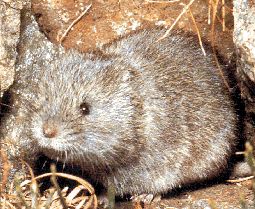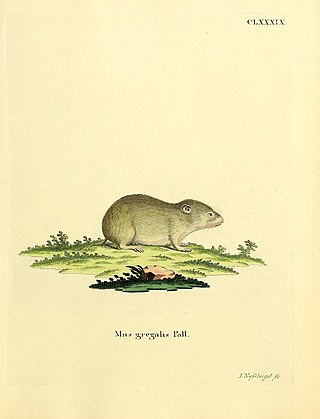
The Arvicolinae are a subfamily of rodents that includes the voles, lemmings, and muskrats. They are most closely related to the other subfamilies in the Cricetidae. Some authorities place the subfamily Arvicolinae in the family Muridae along with all other members of the superfamily Muroidea. Some refer to the subfamily as the Microtinae or rank the taxon as a full family, the Arvicolidae.

Microtus is a genus of voles found in North America, Europe and northern Asia. The genus name refers to the small ears of these animals. They are stout rodents with short ears, legs and tails. They eat green vegetation such as grasses and sedges in summer, and grains, seeds, root and bark at other times. The genus is also called "meadow voles".

The rock vole, also known as the yellow-nosed vole, is a medium-sized species of vole found in eastern North America.

Water voles are large voles in the genus Arvicola. They are found in both aquatic and dry habitat through Europe and much of northern Asia. A water vole found in Western North America was historically considered a member of this genus, but has been shown to be more closely related to members of the genus Microtus. Head and body lengths are 12–22 cm, tail lengths are 6.5–12.5 cm, and their weights are 70–250 g. The animals may exhibit indeterminate growth. They are thick-furred and have hairy fringes on their feet that improve their swimming ability.

Alticola is a genus of rodent in the family Cricetidae.
The flat-headed vole, also called the flat-headed mountain vole or Strelzov's mountain vole, is a species of rodent in the family Cricetidae. It is found in China, Kazakhstan, Mongolia, and Russian Federation.

Chionomys is a genus of rodent in the family Cricetidae.

Ellobius is a genus of rodents in the family Cricetidae. It contains two of the handful of examples of mammal species that have lost the Y chromosome.

Eothenomys is a genus of rodent in the family Cricetidae. It contains the following species:
The Shansei vole is a species of rodent in the family Cricetidae. It is found only in north-central China where its habitat is forests.
True's vole is a species of rodent in the family Cricetidae. It is found in India and Pakistan.
The Murree vole is a species of rodent in the family Cricetidae. It is endemic to the Himalayas in Pakistan and India. It was named by William Thomas Blanford after its collector, geologist Arthur Beavor Wynne.

Brandt's vole,, also known as the steppe vole, is a species of rodent in the family Cricetidae. It is native to shrublands and grasslands in Russia, Mongolia and northern China.
The Mediterranean pine vole is a species of rodent in the family Cricetidae. It is found in France, Andorra, Portugal, and Spain where it lives in a network of shallow tunnels.

The narrow-headed vole is a species of rodent in the family Cricetidae. It was previously placed in the genus Microtus, but modern listings either lump this into genus Lasiopodomys or split it out into Stenocranius. It ranges over northern and central Asia.

The East European vole is a species of vole (rodent) in the family Cricetidae.
The Clethrionomyini are a tribe of forest voles in the subfamily Arvicolinae. This tribe was formerly known as Myodini, but when genus Myodes was deemed to be a junior synonym, the tribe was renamed. Species in this tribe are:
Neodon is a genus of rodent in the family Cricetidae. Species within Neodon are classified as relics of the Pleistocene epoch because the occlusal patterns resemble the extinct Allophaiomys.

The Western Himalayan subalpine conifer forests is a temperate coniferous forests ecoregion of the middle and upper elevations of the western Middle Himalayas of Nepal, India, and Pakistan.

Microtini is a tribe of voles in the subfamily Arvicolinae.




















